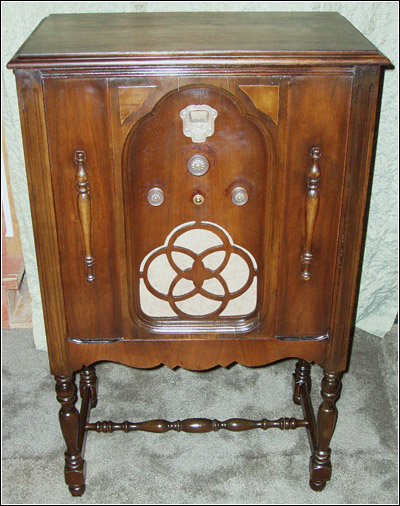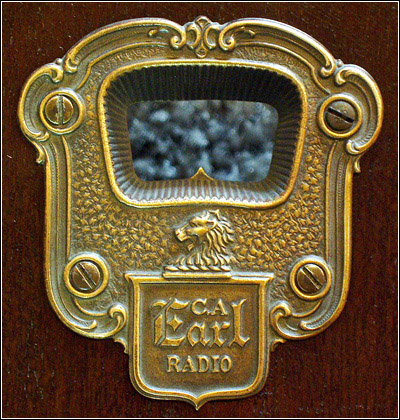Of Old Radios And Related Items--Published Monthly
The Radio with Two Names --Freed-Eisemann or Earl?
BY JEROME WIELAND
Web Edition
Vintage radios with mystery or duplicate labels always provoke interest. Jerry Wieland's anniversary gift console also turned out to be a challenging restoration project. (Editor)
For a wedding anniversary present, my brother presented my wife and me with an old console he found at an estate sale. Figure 1 shows it in restored condition. At the time, It impressed me more than it did my wife.
The cabinet was in good condition, except for the top which had severe veneer damage. The chassis was clean and had all its tubes, as shown in Figure 2 (see complete PDF or print version). I noticed the name C.A. Earl on the metal dial escutcheon, shown in Figure 3.
However, a large label on the back of the chassis stated it was a Freed Radio Model NR-55 or 56 manufactured by Freed-Eisemann, as shown in Figure 4. Then I noticed the speaker label also had the C.A. Earl name. See Figure 5 (see complete PDF or print version). I had heard of the Freed-Eisemann Company but not C.A Earl.
Figure 1. My restored Earl -- or is it a Freed-Eisemann?When I consulted my radio reference books, I learned that C.A. Earl was president of the Freshman Company, and in 1928 had bought the Freed-Eisemann Company. He planned to merge it with the Freshman Company and produce two product lines in one large new factory. He would keep the Freed-Eisemann name for one line but replace the Freshman name with his own name for the other line. Production in the new factory began in mid-1929, but both lines were in receivership by the end of 1929 due to the stock market crash, according to Alan Douglas in Volume 2 of Radio Manufacturers of the 1920's. I assume that my radio was produced as an Earl model during this period.
The Restoration Project
Now that my curiosity was satisfied, I began an examination of the chassis and speaker. When I removed both from the cabinet, the speaker first caught my attention. Half of the leather surround was missing and the remainder was dried and cracked. What was left of the thin, white paper cone had curled like a potato chip. It began to tear when I tried to unravel it. The cone was history.
I set the speaker aside to determine the chassis state. The power toggle switch was not working, but some WD-40 unstuck it. An audio interstage coupling transformer had an open winding. A search of my transformer stock yielded a substitute.
The volume control is an unusual dual-stage affair. Unfortunately, the rear stage wasn't working. When I disassembled it, I found that the resistive element was badly worn and open. Searching through my control stock, I found a single-stage pot of similar design and was able to couple it mechanically to the good front stage. It pays to keep old parts!
Everything else looked OK, including the power transformer and the power supply filter capacitors, which was quite a surprise. I selected a permanent magnet speaker and an audio transformer with a primary center tap to match the push-pull 71A audio tubes. With the aid of numerous clip leads, the radio sprang to life. Some quick alignment yielded decent sensitivity and audio quality. Those power supply filter caps really did work. No hum was present.
The Speaker
Now I had to decide what to do about the speaker. I wanted to use the Earl speaker if at all possible since it seemed rather unusual. It has no field coil. The label describes it as an Inductor Dynamic Speaker Model 375.
An Internet search revealed that this type of speaker was used during the 1920s for a short time before moving voice coil speakers became popular due to their better sound quality. The inductor type was said to have poor high frequency response, according to the Wikipedia article I found on the Internet.
Figure 3. An Earl radio or so says the escutcheon.With the speaker cover removed, two large pole pieces and a transformer with a center tapped primary are visible, as shown in Figure 6 (see complete PDF or print version). The word inductor in the speaker name refers to an induction motor which this speaker drive mechanism is said to resemble. The threaded shaft that attaches to the speaker cone is referred to as an armature and is activated by the transformer secondary field, according to a 1929 Popular Mechanics article.
I remembered having an old speaker of about the same diameter in the garage attic. The field coil was open, but I decided years ago to keep it because the cone was in good condition. I was able to find it, but the cone diameter was too small. It barely made contact with the edge of the Earl speaker basket. The original Earl cone had a stiff cardboard ring which I decided to use as a diameter expander. Gluing it to the edge of the smaller cone would allow me to glue the cone to the basket edge.
Figure 4. Not so quick! It's a Freed-Eisemann NR-55 or 56 according to the metal tag on the chassis.The next problem was how to attach the cone to the armature. My replacement cone had a spider-type attachment, but the Earl has a metal nose with a small hole for the armature shaft to pass through, as shown in Figure 7 (see complete PDF or print version). Two nuts are used to attach the armature to the cone. I decided to remove the Earl metal nose and graft it onto the replacement cone. After I removed the spider from the replacement cone, I glued the Earl nose inside the replacement cone.
I had to lengthen the armature shaft to reach the new cone. I did this by attaching a screw to the armature with a thicker than normal nut and threading both into this nut. I then secured the metal nose to the extension with another nut behind the screw head. I carefully aligned the cone extension ring to the speaker basket, clamped it temporarily in place, and hot-melt glued the ring to the basket. The restored speaker is seen in Figure 8 (see complete PDF or print version).
When I first tried this reworked speaker, the audio volume was low. By readjusting the nose location on the armature, I found the optimum position and the volume improved. As stated in a Wikipedia article, there is a lack of high frequency response. However, I am going to keep the Earl speaker in the Earl radio just as C.A. intended.
The final tasks were to clean the cabinet, apply some stain to the scratches, and attached a new piece of walnut veneer to the top. As indicated earlier, Figure 1 shows the completed project.
References:
Douglas, Alan. Radio Manufacturers of the 1920's, Vol. 2. Chandler, Az.: Sonoran Publishing LLC, 1995.
Popular Mechanics. "The New Inductor Dynamic Speaker," November 1929, p. 827.
Wikipedia, The Free Encyclopedia. Entry for "moving iron speaker," section "inductor dynamic speaker."
Jerry Wieland is a retired electrical engineer and a member of the Antique Radio Club of Illinois (ARCI). His interest in old radios began at age 12 when he started listening to shortwave broadcasts on a 1930s Silvertone console. Website: http://home.comcast.net/~jeromewieland/site/
|
[Free Sample] [Books, etc., For Sale] [Subscribe to A.R.C./Renew] [Classified Ads] [Auction Prices] [Event Calendar] [Links] [Home] [Issue Archives] [Book Reviews] [Subscription Information] [A.R.C. FAQ]URL = http://www.antiqueradio.com/Jul10_Wieland_Two_Names.html Copyright © 1996-2010 by John V. Terrey - For personal use only. Last revised: June 30, 2010. For Customer Assistance please contact ARC@antiqueradio.com or call (866) 371-0512 toll free Antique Radio Classified |


